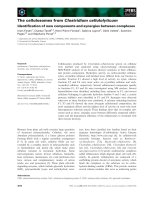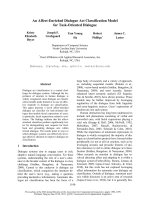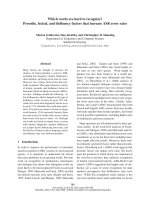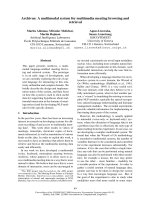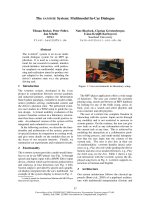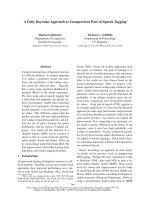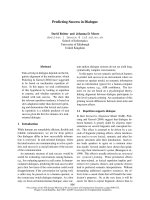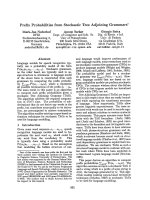Báo cáo khoa học: "Scaling up from Dialogue to Multilogue: some principles and benchmarks" doc
Bạn đang xem bản rút gọn của tài liệu. Xem và tải ngay bản đầy đủ của tài liệu tại đây (91.86 KB, 8 trang )
Proceedings of the 43rd Annual Meeting of the ACL, pages 231–238,
Ann Arbor, June 2005.
c
2005 Association for Computational Linguistics
Scaling up from Dialogue to Multilogue: some principles and benchmarks
Jonathan Ginzburg and Raquel Fern
´
andez
Dept of Computer Science
King’s College, London
The Strand, London WC2R 2LS
UK
{ginzburg,raquel}@dcs.kcl.ac.uk
Abstract
The paper considers how to scale up dialogue
protocols to multilogue, settings with multiple
conversationalists. We extract two benchmarks
to evaluate scaled up protocols based on the
long distance resolution possibilities of non-
sentential utterances in dialogue and multi-
logue in the British National Corpus. In light
of these benchmarks, we then consider three
possible transformations to dialogue protocols,
formulated within an issue-based approach to
dialogue management. We show that one such
transformation yields protocols for querying
and assertion that fulfill these benchmarks.
1 Introduction
The development of dialogue systems in which a human
agent interacts using natural language with a computa-
tional system is by now a flourishing domain (see e.g.
(NLE, 2003)), buttressed by an increasing theoretical and
experimental literature on the properties of dialogue (see
e.g. recent work in the SEMDIAL and SIGDIAL confer-
ences). In contrast, the development of multilogue sys-
tems, in which conversation with 3 or more participants
ensue—is still in its early stages, as is the theoretical and
experimental study of multilogue. The fundamental issue
in tackling multilogue is: how can mechanisms motiv-
ated for dialogue (e.g. information states, protocols, up-
date rules etc) be scaled up to multilogue?
In this paper we extract from a conversational cor-
pus, the British National Corpus (BNC), several bench-
marks that characterize dialogue and multilogue inter-
action. These are based on the resolution possibilities
of non-sentential utterances (NSUs). We then use these
benchmarks to evaluate certain general transformations
whose application to a dialogue interaction system yield
a system appropriate for multilogue.
There are of course various plausible views of the rela-
tion between dialogue and multilogue. One possible ap-
proach to take is to view multilogue as a sequence of dia-
logues. Something like this approach seems to be adop-
ted in the literature on communication between autonom-
ous software agents. However, even though many situ-
ations considered in multiagent systems do involve more
than two agents, most interaction protocols are designed
only for two participants at a time. This is the case of
the protocol specifications provided by FIPA (Foundation
for Intelligent Physical Agents) for agent communication
language messages (FIPA, 2003). The FIPA interaction
protocols (IP) are most typically designed for two parti-
cipants, an initiator and a responder . Some IPs permit the
broadcasting of a message to a group of addressees, and
the reception of multiple responses by the original initi-
ator (see most particularly the Contract Net IP). However,
even though more than two agents participate in the com-
municative process, as (Dignum and Vreeswijk, 2003)
point out, such conversations can not be considered mul-
tilogue, but rather a number of parallel dialogues.
The Mission Rehearsal Exercise (MRE) Project
(Traum and Rickel, 2002), one of the largest multilogue
systems developed hitherto, is a virtual reality envir-
onment where multiple partners (including humans and
other autonomous agents) engage in multi-conversation
situations. The MRE is underpinned by an approach to
the modelling of interaction in terms of obligations that
different utterance types bring about originally proposed
for dialogue (see e.g. (Matheson et al. , 2000)). In par-
ticular, this includes a model of the grounding process
(Clark, 1996) that involves recognition and construction
of common ground units (CGUs) (see (Traum, 2003)).
Modelling of obligations and grounding becomes more
complex when considering multilogue situations. The
model of grounding implemented in the MRE project can
only be used in cases where there is a single initiator and
responder. It is not clear what the model should be for
231
multiple addressees: should the contents be considered
grounded when any of the addressees has acknowledged
them? Should evidence of understanding be required
from every addressee?
Since their resolution is almost wholly reliant on con-
text, non sentential utterances provide a large testbed con-
cerning the structure of both dialogue and multilogue. In
section 2 we present data from the British National Cor-
pus (BNC) concerning the resolution of NSUs in dialogue
and multilogue. The main focus of this data is with the
distance between antecedent and fragment. We use this
to extract certain benchmarks concerning multilogue in-
teraction. Thus, acknowledgement and acceptance mark-
ers (e.g. ‘mmh’, ‘yeah’) are resolved with reference to
an utterance (assertion) which they ground (accept). The
data we provide shows that acknowledgements in mul-
tilogue, as in dialogue, are adjacent to their antecedent.
This provides evidence that, in general, a single addressee
serves to signal grounding. In contrast, BNC data indic-
ates the prevalence in multilogue of short answers that
are resolved using material from an antecedent question
located several turns back, whereas in dialogue short an-
swers are generally adjacent to their antecedent. This
provides evidence against reducing querying interaction
in multilogue to a sequence of dialogues. We show that
long distance short answers are a stable phenomenon for
multilogue involving both small (≤5 persons) and large
(> 5 persons) groups, despite the apparently declining
interactivity with increasing group size flagged in exper-
imental work (see (Fay et al., 2000)).
In section 3 we sketch the basic principles of issue
based dialogue management which we use as a basis
for our subsequent investigations of multilogue interac-
tion. This will include information states and formula-
tion of protocols for querying and assertion in dialogue.
In section 4 we consider three possible transformations
on dialogue protocols into multilogue protocols. These
transformations are entirely general in nature and could
be applied to protocols stated in whatever specification
language. We evaluate the protocols that are generated
by these transformations with reference to the bench-
marks extracted in section 2. In particular, we show
that one such transformation, dubbed Add Side Parti-
cipants(ASP), yields protocols for querying and asser-
tion that fulfill these benchmarks. Finally, section 5
provides some conclusions and pointers to future work.
2 Long Distance Resolution of NSUs in
Dialogue and Multilogue: some
benchmarks
The work we present in this paper is based on empir-
ical evidence provided by corpus data extracted from the
British National Corpus (BNC).
2.1 The Corpus
Our current corpus is a sub-portion of the BNC conversa-
tional transcripts consisting of 14,315 sentences. The cor-
pus was created by randomly excerpting a 200-speaker-
turn section from 54 BNC files. Of these files, 29 are
transcripts of conversations between two dialogue parti-
cipants, and 25 files are multilogue transcripts.
A total of 1285 NSUs were found in our sub-corpus.
Table 1 shows the raw counts of NSUs found in the dia-
logue and multilogue transcripts, respectively.
NSUs BNC files
Dialogue 709 29
Multilogue 576 25
Total 1285 54
Table 1: Total of NSUs in Dialogue and Multilogue
All NSUs encountered within the corpus were clas-
sified according to the NSU typology presented in
(Fern
´
andez and Ginzburg, 2002). Additionally, the dis-
tance from their antecedent was measured.
1
Table 2
shows the distribution of NSU categories and their ante-
cedent separation distance. The classes of NSU which
feature in our discussion below are boldfaced.
The BNC annotation includes tagging of units approx-
imating to sentences, as identified by the CLAWS seg-
mentation scheme (Garside, 1987). Each sentence unit is
assigned an identifier number. By default it is assumed
that sentences are non-overlapping and that their numer-
ation indicates temporal sequence. When this is not the
case because speakers overlap, the tagging scheme en-
codes synchronous speech by means of an alignment map
used to synchronize points within the transcription. How-
ever, even though information about simultaneous speech
is available, overlapping sentences are annotated with dif-
ferent sentence numbers.
In order to be able to measure the distance between
the NSUs encountered and their antecedents, all instances
were tagged with the sentence number of their antecedent
utterance. The distance we report is therefore measured
in terms of sentence numbers. It should however be noted
that taking into account synchronous speech would not
change the data reported in Table 2 in any significant
1
This classification was done by one expert annotator. To
assess its reliability a pilot study of the taxonomy was per-
formed using two additional non-expert coders. These annot-
ated 50 randomly selected NSUs (containing a minimum of 2
instances of each NSU class, as labelled by the expert annot-
ator.). The agreement achieved by the three coders is reasonably
good, yielding a kappa score κ = 0.76. We also assessed the ac-
curacy of the coders’ choices in choosing the antecedent utter-
ance using the expert annotator’s annotation as a gold standard.
Given this, one coder’s accuracy was 92%, whereas the other
coder’s was 96%.
232
Distance
NSU Class Example Total 1 2 3 4 5 6 >6
Acknowledgment Mm mm. 595 578 15 2
Short Answer Ballet shoes. 188 104 21 17 5 5 8 28
Affirmative Answer Yes. 109 104 4 1
Clarification Ellipsis John? 92 76 13 2 1
Repeated Ack. His boss, right. 86 81 2 3
Rejection No. 50 49 1
Factual Modifier Brilliant! 27 23 2 1 1
Repeated Aff. Ans. Very far, yes. 26 25 1
Helpful Rejection No, my aunt. 24 18 5 1
Check Question Okay? 22 15 7
Filler a cough. 18 16 1 1
Bare Mod. Phrase On the desk. 16 11 4 1
Sluice When? 11 10 1
Prop. Modifier Probably. 11 10 1
Conjunction Phrase Or a mirror. 10 5 4 1
Total 1285 1125 82 26 9 7 8 28
Percentage 100 87.6 6.3 2 0.6 0.5 0.6 2.1
Table 2: NSUs sorted by Class and Distance
way, as manual examination of all NSUs at more than
distance 3 reveals that the transcription portion between
antecedent and NSU does not contain any completely
synchronous sentences in such cases.
In the examples throughout the paper we shall use ital-
ics to indicate speech overlap. When italics are not used,
utterances take place sequentially.
2.2 NSU-Antecedent Separation Distance
The last row in Table 2 shows the distribution of NSU-
antecedent separation distances as percentages of the
total of NSUs found. This allows us to see that about
87% of NSUs have a distance of 1 sentence (i.e. the ante-
cedent was the immediately preceding sentence), and that
the vast majority (about 96%) have a distance of 3 sen-
tences or less.
Although the proportion of NSUs found in dialogue
and multilogue is roughly the same (see Table 1 above),
when taking into account the distance of NSUs from their
antecedent, the proportion of long distance NSUs in mul-
tilogue increases radically: the longer the distance, the
higher the proportion of NSUs that were found in multi-
logue. In fact, as Table 3 shows, NSUs that have a dis-
tance of 7 sentences or more appear exclusively in multi-
logue transcripts. These differences are significant (χ
2
=
62.24, p ≤ 0.001).
Adjacency of grounding and affirmation utterances
The data in table 2 highlights a fundamental charac-
teristic of the remaining majoritarian classes of NSUs,
Ack(nowledgements), Affirmative Answer, CE (clari-
fication ellipsis), Repeated Ack(nowledgements), and
Rejection. These are used either in grounding interac-
tion, or to affirm/reject propositions.
2
The overwhelming
adjacency to their antecedent underlines the locality of
these interactions.
Long distance potential for short answers One strik-
ing resultexhibited in Table 2 is the uneven distribution of
long distance NSUs across categories. With a few excep-
tions, NSUs that have a distance of 3 sentences or more
are exclusively short answers. Not only is the long dis-
tance phenomenon almost exclusively restricted to short
answers, but the frequency of long distance short answers
stands in strong contrast to the other NSUs classes; in-
deed, over 44% of short answers have more than distance
1, and over 24% have distance 4 or more, like the last
answer in the following example:
(1) Allan: How much do you think?
Cynthia: Three hundred pounds.
Sue: More.
Cynthia: A thousand pounds.
Allan: More.
Unknown: <unclear>
Allan: Eleven hundred quid apparently.
[BNC, G4X]
Long distance short answers primarily a multilogue
effect Table 4 shows the total number of short answers
found in dialogue and multilogue respectively, and the
proportions sorted by distance over those totals:
From this it emerges that short answers are more
common in multilogue than in dialogue—134(71%) v.
2
Acknowledgements and acceptances are, in principle, dis-
tinct acts: the former involves indication that an utterance has
been understood, whereasthe latter that an assertion is accepted.
In practice, though, acknowledgements in the form of NSUs
commonly simultaneously signal acceptances. Given this, cor-
pus studies of NSUs (e.g. (Fern
´
andez and Ginzburg, 2002)) of-
ten conflate the two.
233
Distance 1 2 3 4 5 6 >6
Dialogue 658 (59%) 37 (45%) 11 (45%) 1 (12%) 1 (14%) 1 (13%) 0 (0%)
Multilogue 467 (41%) 45 (55%) 15 (55%) 8 (88%) 6 (86%) 7 (87%) 28 (100%)
Table 3: NSUs in dialogue and multilogue sorted by distance
Short Answers Total # 1 2 3 > 3
Dialogue 54 82 9 9 0
Multilogue 134 44 11 8 37
Table 4: % over the totals found in dialogue and multilogue
54(29%). Also, the distance pattern exhibited by these
two groups is strikingly different: Only 18% of short an-
swers found in dialogue have a distance of more than 1
sentence, with all of them having a distance of at most 3,
like the short answer in (2).
(2) Malcolm: [ ] cos what’s three hundred and
sixty divided by seven?
Anon 1: I don’t know.
Malcolm: Yes I don’t know either!
Anon 1: Fifty four point fifty one point four.
[BNC, KND]
This dialogue/multilogueasymmetry argues againstre-
ductive views of multilogue as sequential dialogue.
Long Distance short answers and group size As
Table 4 shows, all short answers at more than distance
3 appear in multilogues. Following (Fay et al., 2000),
we distinguish between small groups (those with 3 to 5
participants) and large groups (those with more than 5
participants). The size of the group is determined by the
amount of participants that are active when a particular
short answer is uttered. We consider active participants
those that have made a contribution within a window of
30 turns back from the turn where the short answer was
uttered.
Table 5 shows the distribution of long distance short
answers (distance > 3) in small and large groups respect-
ively. This indicates that long distance short answers are
significantly more frequent in large groups (χ
2
= 22.17,
p ≤ 0.001), though still reasonably common in small
groups. A pragmatic account correlating group size and
frequency of long distance short answers is offered in the
final paragraph of section 3.
Group Size d > 3 d ≤ 3 Total
≤ 5 20 73 93
(21.5%) (78.5%)
> 5 26 15 41
(63%) (37%)
Table 5: Long distance short answers in small and large groups
Large group multilogues in the corpus are all tran-
scripts of tutorials, training sessions or seminars, which
exhibit a rather particular structure. The general pat-
tern involves a question being asked by the tutor or ses-
sion leader, the other participants then taking turns to an-
swer that question. The tutor or leader acts as turn man-
ager. She assigns the turn explicitly usually by addressing
the participants by their name without need to repeat the
question under discussion. An example is shown in (3):
(3) Anon1: How important is those three components
and what value would you put on them [ ]
Anon3: Tone forty five. Body language thirty .
Anon1: Thank you.
Anon4: Oh.
Anon1: Melanie.
Anon5: twenty five.
Anon1: Yes.
Anon5: Tone of voice twenty five. [BNC, JYM]
Small group multilogues on the other hand have a more
unconstrained structure: after a question is asked, the par-
ticipants tend to answer freely. Answers by different par-
ticipants can follow one after the other without explicit
acknowledgements nor turn management, like in (4):.
(4) Anon 1: How about finance then? <pause>
Unknown 1: Corruption
Unknown 2: Risk <pause dur=30>
Unknown 3: Wage claims <pause dur=18>
2.3 Two Benchmarks of multilogue
The data we have seen above leads in particular to the fol-
lowing two benchmarks protocols for querying, assertion,
and grounding interaction in multilogue:
(5) a. Multilogue Long Distance short answers
(MLDSA): querying protocols for multilogue
must license short answers an unbounded num-
ber of turns from the original query.
b. Multilogue adjacency of ground-
ing/acceptance (MAG): assertion and ground-
ing protocols for multilogue should license
grounding/clarification/acceptance moves only
adjacently to their antecedent utterance.
MLDSA and MAG have a somewhat different status:
whereas MLDSA is a direct generalization from the data,
MAG is a negative constraint, posited given the paucity of
positive instances. As such MAG is more open to doubt
and we shall treat it as such in the sequel.
234
3 Issue based Dialogue Management:
basic principles
In this section we outline some of the basic principles
of Issue-based Dialogue Management, which we use as
a basis for our subsequent investigations of multilogue
interaction.
Information States We assume information states of
the kind developed in the KoS framework (e.g. (Gin-
zburg, 1996, forthcoming), (Larsson, 2002)) and imple-
mented in systems such as GODIS, IBIS, and CLARIE
(see e.g. (Larsson, 2002; Purver, 2004)). On this
view each dialogue participant’s view of the common
ground, their Dialogue Gameboard (DGB), is structured
by a number of attributes including the following three:
FACTS: a set of facts representing the shared assump-
tions of the CPs, LatestMove: the most recent groun-
ded move, and QUD (‘questions under discussion’): a
partially ordered set—often taken to be structured as a
stack—consisting of the currently discussable questions.
Querying and Assertion Both querying and asser-
tion involve a question becoming maximal in the quer-
ier/asserter’s QUD:
3
the posed question q for a query
where q is posed, the polar question p? for an assertion
where p is asserted. Roughly, the responder can sub-
sequently either choose to start a discussion (of q or p?)
or, in the case of assertion, to update her FACTS structure
with p. A dialogue participant can downdate q/p? from
QUD when, as far as her (not necessarily public) goals
dictate, sufficient information has been accumulated in
FACTS. The querying/assertion protocols (in their most
basic form) are summarized as follows:
(6)
querying assertion
LatestMove = Ask(A,q) LatestMove = Assert(A,p)
A: push q onto QUD; A: push p? onto QUD;
release turn; release turn
B: push q onto QUD; B: push p? onto QUD;
take turn; take turn;
make max-qud–specific; Option 1: Discuss p?
utterance
4
take turn. Option 2: Accept p
LatestMove = Accept(B,p)
B: increment FACTS with p;
pop p? from QUD;
A: increment FACTS with p;
pop p? from QUD;
Following (Larsson, 2002; Cooper, 2004), one can
3
In other words, pushed onto the stack, if one assumes QUD
is a stack.
4
An utterance whose content is either a proposition p About
max-qud or a question q
1
on which max-qud Depends. For the
latter see footnote 7. If one assumes QUD to be a stack, then
‘max-qud–specific’ will in this case reduce to ‘q–specific’. But
the more general formulation will be important below.
decompose interaction protocols into conversational
update rules—functions from DGBs into DGBs using
Type Theory with Records (TTR). This allows simple
interfacing with the grammar, a Constraint-based Gram-
mar closely modelled on HPSG but formulated in TTR
(see (Ginzburg, forthcoming)).
Grounding Interaction Grounding an utterance u : T
(‘the sign associated with u is of type T’) is modelled as
involving the following interaction. (a) Addressee B tries
to anchor the contextual parameters of T. If successful,
B acknowledges u (directly, gesturally or implicitly) and
responds to the content of u. (b) If unsuccessful, B poses
a Clarification Request (CR), that arises via utterance co-
ercion (see (Ginzburg and Cooper, 2001)). For reasons
of space we do not formulate an explicit protocol here—
the structure of such a protocol resembles the assertion
protocol. Our subsequent discussion of assertion can be
modified mutatis mutandis to grounding.
NSU Resolution We assume the account of NSU res-
olution developed in (Ginzburg and Sag, 2000). The
essential idea they develop is that NSUs get their main
predicates from context, specifically via unification with
the question that is currently under discussion, an entity
dubbed the maximal question under discussion (MAX-
QUD). NSU resolution is, consequently, tied to conver-
sational topic, viz. the MAX-QUD.
5
Distance effects in dialogue short answers If one as-
sumes QUD to be a stack, this affords the potential for
non adjacent short answers in dialogue. These, as dis-
cussed in section 2, are relatively infrequent. Two com-
monly observed dialogue conditions will jointly enforce
adjacency between short answers and their interrogative
antecedents: (a) Questions have a simple, one phrase
answer. (b) Questions can be answered immediately,
without preparatory or subsequent discussion. For multi-
logue (or at least certain genres thereof), both these con-
ditions are less likely to be maintained: different CPs
can supply different answers, even assuming that relat-
ive to each CP there is a simple, one phrase answer. The
more CPs there are in a conversation, the smaller their
common ground and the more likely the need for cla-
rificatory interaction. A pragmatic account of this type
of the frequency of adjacency in dialogue short answers
seems clearly preferable to any actual mechanism that
would rule out long distance short answers. These can
be perfectly felicitous—see e.g. example (1) above which
5
The resolution of NSUs, on the approach of (Ginzburg and
Sag, 2000), involves one other parameter, an antecedent sub-
utterance they dub the salient-utterance (SAL-UTT). This plays
a role similar to the role played by the parallel element in higher
order unification–based approaches to ellipsis resolution (see
e.g. (Pulman, 1997). For current purposes, we limit attention
to the MAX-QUD as the nucleus of NSU resolution.
235
would work fine if the turn uttered by Sue had been
uttered by Allan instead. Moreover such a pragmatic ac-
count leads to the expectation that the frequency of long
distance antecedents is correlated with group size, as in-
deed indicated by the data in table 5.
4 Scaling up Protocols
(Goffman, 1981) introduced the distinction between rat-
ified participants and overhearers in a conversation.
Within the former are located the speaker and participants
whom she takes into account in her utterance design—
the intended addressee(s) of a given utterance, as well
as side participants. In this section we consider three
possible principles of protocol extension, each of which
can be viewed as adding roles for participants from one
of Goffman’s categories. We evaluate the protocol that
results from the application of each such principle re-
lative to the benchmarks we introduced in section 2.3.
Seen in this light, the final principle we consider, Add
Side Participants (ASP), arguably, yields the best res-
ults. Nonetheless, these three principles would appear to
be complementary—the most general protocol for mul-
tilogue will involve, minimally, application of all three.
6
We state the principles informally and framework inde-
pendently as transformations on operational construals of
the protocols. In a more extended presentation we will
formulate these as functions on TTR conversational up-
date rules.
The simplest principle is Add Overhearers (AOV).
This involves adding participants who merely observe the
interaction. They keep track of facts concerning a par-
ticular interaction, but their context is not facilitated for
them to participate:
(7) Given a dialogue protocol π, add roles C
1
, ,C
n
where each C
i
is a silent participant: given an ut-
terance u
0
classified as being of type T
0
, C
i
up-
dates C
i
.DGB.FACTS with the proposition u
0
:
T
0
.
Applying AOV yields essentially multilogues which
are sequences of dialogues. A special case of this are
moderated multilogues, where all dialogues involve a
designated individual (who is also responsible for turn
assignment.). Restricting scaling up to applications of
AOV is not sufficient since inter alia this will not fulfill
the MLDSA benchmark.
A far stronger principle is Duplicate Responders
(DR):
(8) Given a dialogue protocol π, add roles C
1
, ,C
n
which duplicate the responder role.
6
We thank an anonymous reviewer for ACL for convincing
us of this point.
Applying DR to the querying protocol yields the fol-
lowing protocol:
(9) Querying with multiple responders
1. LatestMove = Ask(A,q)
2. A: push q onto QUD; release turn
3. Resp
1
: push q onto QUD; take turn; make max-qud–
specific utterance; release turn
4. Resp
2
: push q onto QUD; take turn; make max-qud–
specific utterance; release turn
5.
6. Resp
n
: push q onto QUD; take turn; make max-qud–
specific utterance; release turn
This yields interactions such as (4) above. The query-
ing protocol in (9) licenses long distance short answers,
so satisfies the MLDSA benchmark. On the other hand,
the contextual updates it enforces will not enable it to deal
with the following (constructed) variant on (4), in other
words does not afford responders to comment on previ-
ous responders, as opposed to the original querier:
(10) A: Who should we invite for the conference?
B: Svetlanov.
C: No (=Not Svetlanov), Zhdanov
D: No (= Not Zhdanov, = Not Svetlanov), Gergev
Applying DR to the assertion protocol will yield the
following protocol:
(11) Assertion with multiple responders
1. LatestMove = Assert(A,p)
2. A: push p? onto QUD; release turn
3. Resp
1
: push p? onto QUD; take turn; Option 1:
Discuss p?, Option 2: Accept p
4. Resp
2
: push p? onto QUD; take turn; Option 1:
Discuss p?, Option 2: Accept p
5.
6. Resp
n
: push p? onto QUD; take turn; Option 1:
Discuss p?, Option 2: Accept p
One arguable problem with this protocol—equally
applicable to the corresponding DRed grounding
protocol—is that it licences long distance acceptance and
is, thus, inconsistent with the MAG benchmark. On the
other hand, it is potentially useful for interactions where
there is explicitly more than one direct addressee.
A principle intermediate between AOV and DR is Add
Side Participants (ASP):
(12) Given a dialogue protocol π, add roles
C
1
, ,C
n
, which effect the same contextual up-
date as the interaction initiator.
Applying ASP to the dialogue assertion protocol yields
the following protocol:
(13) Assertion for a conversation involving
{A,B,C
1
,. . . ,C
n
}
236
1. LatestMove = Assert(A,p)
2. A: push p? onto QUD; release turn
3. C
i
: push p? onto QUD;
4. B: push p? onto QUD; take turn; Option 1: Accept
p, Option 2: Discuss p?
(14) 1. LatestMove = Accept(B,p)
2. B: increment FACTS with p; pop p? from QUD;
3. C
i
:increment FACTS with p; pop p? from QUD;
4. A: increment FACTS with p; pop p? from QUD;
This protocol satisfies the MAG benchmark in that ac-
ceptance is strictly local. This is because it enforces
communal acceptance—acceptance by one CP can count
as acceptance by all other addressees of an assertion.
There is an obvious rational motivation for this, given the
difficulty of a CP constantly monitoring an entire audi-
ence (when this consists of more than one addressee) for
acceptance signals—it is well known that the effect of
visual access on turn taking is highly significant (Dabbs
and Ruback, 1987). It also enforces quick reaction to
an assertion—anyone wishing to dissent from p must get
their reaction in early i.e. immediately following the as-
sertion since further discussion of p? is not countenanced
if acceptance takes place. The latter can happen of course
as a consequence of a dissenter not being quick on their
feet; on this protocol to accommodate such cases would
require some type of backtracking.
Applying ASP to the dialogue querying protocol yields
the following protocol:
(15) Querying for a conversation involving
{ A,B,C
1
,. . . ,C
n
}
1. LatestMove = Ask(A,q)
2. A: push q onto QUD; release turn
3. C
i
: push q onto QUD;
4. B: push q onto QUD; take turn; make max-qud–
specific utterance.
This improves on the DR generated protocol be-
cause it does allow responders to comment on previous
responders—the context is modified as in the dialogue
protocol. Nonetheless, as it stands, this protocol won’t
fully deal with examples such as (4)—the issue intro-
duced by each successive participant takes precedence
given that QUD is assumed to be a stack. This can be
remedied by slightly modifying this latter assumption:
we will assume that when a question q is pushed onto
QUD it doesn’t subsume all existing questions in QUD,
but rather only those on which q does not depend:
7
(16) q is QUD
mod(dependence)
maximal iff for any q
0
in
QUD such that ¬Depend(q, q
1
): q q
0
.
7
The notion of dependence we assume here is one common
in work on questions, e.g. (Ginzburg and Sag, 2000), intuitively
corresponding to the notion of ‘is a subquestion of’. q
1
depends
on q
2
iff any proposition p such that p resolves q
2
also satisfies
p is about q
1
.
This is conceptually attractive because it reinforces
that the order in QUD has an intuitive semantic basis.
One effect this has is to ensure that any polar question
p? introduced into QUD, whether by an assertion or by
a query, subsequent to a wh-question q on which p? de-
pends does not subsume q. Hence, q will remain access-
ible as an antecedent for NSUs, as long as no new unre-
lated topic has been introduced. Assuming this modifica-
tion to QUD is implemented in the above ASP–generated
protocols, both MLDSA and MAG benchmarks are ful-
filled.
5 Conclusions and Further Work
In this paper we consider how to scale up dialogue proto-
cols to multilogue, settings with multiple conversation-
alists. We have extracted two benchmarks, MLDSA
and MAG, to evaluate scaled up protocols based on the
long distance resolution possibilities of NSUs in dialogue
and multilogue in the BNC. MLDSA, the requirement
that multilogue protocols license long distance short an-
swers, derives from the statistically significant increase
in frequency of long distance short answers in multi-
logue as opposed to dialogue. MAG, the requirement
that multilogue protocols enforce adjacency of accept-
ance and grounding interaction, derives from the over-
whelming locality of acceptance/grounding interaction
in multilogue, as in dialogue. In light of these bench-
marks, we then consider three possible transformations
to dialogue protocols formulated within an issue-based
approach to dialogue management. Each transformation
can be intuited as adding roles that correspond to dis-
tinct categories of an audience originally suggested by
Goffman. The three transformations would appear to be
complementary—it seems reasonable to assume that ap-
plication of all three (in some formulation) will be needed
for wide coverage of multilogue. MLDSA and MAG can
be fulfilled within an approach that combines the Add
Side Participants transformation on protocols with an
independently motivated modification of the structure of
QUD from a canonical stack to a stack where maximality
is conditioned by issue dependence.
With respect to long distance short answers our ac-
count licences their occurrence in dialogue, as in mul-
tilogue. We offer a pragmatic account for their low fre-
quency in dialogue, which indeed generalizes to explain
a statistically significant correlation we observe between
their increasedincidence and increasing active participant
size. We plan to carry out more detailed work, both
corpus–based and experimental, in order to evaluate the
status of MAG and, correspondingly to assess just how
local acceptance and grounding interaction really are.
We also intend to implement multilogue protocols in
CLARIE soit can simulate multilogue. We willthen eval-
uate its ability to process NSUs from the BNC.
237
Acknowledgements
We would like to thank three anonymous ACL review-
ers for extremely useful comments, which in particular
forced us to rethink some key issues. We would also like
to thank Pat Healey, Shalom Lappin, Richard Power, and
Matt Purver for discussion, and Zoran Macura and Yo
Sato for help in assessing the NSU taxonomy. Earlier
versions of this work were presented at colloquia at ITRI,
Brighton, and at the Universit
´
e Paris, 7. The research
described here is funded by grant number RES-000-23-
0065 from the Economic and Social Research Council of
the United Kingdom.
References
Special issue on best practice in spoken language dia-
logue systems engineering. 2003. Natural Language
Engineering.
Herbert Clark. 1996. Using Language. Cambridge Uni-
versity Press, Cambridge.
Robin Cooper. 2004. A type theoretic approach to in-
formation state update in issue based dialogue man-
agement. Invited paper, Catalog’04, the 8th Workshop
on the Semantics and Pragmatics of Dialogue, Pompeu
Fabra University, Barcelona.
James Dabbs and R. Barry Ruback. 1987 Dimensions of
group process: amount and structure of vocal interac-
tion. Advances in Experimental Social Psychology 20,
pages 123–169.
Frank P.M. Dignum and Gerard A.W. Vreeswijk. 2003.
Towards a testbed for multi-party dialogues. In Pro-
ceedings of the first International Joint Conference on
Autonomous Agents and Multi-agent Systems (AAMAS
2003).
Nicholas Fay, Simon Garrod, and Jean Carletta. 2000.
Group discussion as interactive dialogue or serial
monologue. Psychological Science, pages 481–486.
Raquel Fern
´
andez and Jonathan Ginzburg. 2002. Non-
sentential utterances: A corpus study. Traitement auto-
matique des languages. Dialogue, 43(2):13–42.
FIPA. 2003. The foundation for intelligent
physical agents. interaction protocol specifications.
http://www.fipa.org.
Roger Garside. 1987. The CLAWS word-tagging sys-
tem, In Roger Garside et al. editors, The computa-
tional analysis of English: a corpus-based approach,
Longman, Harlow, pages 30–41.
Jonathan Ginzburg and Robin Cooper. 2001. Resolv-
ing ellipsis in clarification. In Proceedings of the 39th
Meeting of the Association for Computational Lin-
guistics, Toulouse.
Jonathan Ginzburg and Ivan A. Sag. 2000. Interrogative
Investigations: the form, meaning and use of English
Interrogatives. Number 123 in CSLI Lecture Notes.
CSLI Publications, Stanford: California.
Jonathan Ginzburg. (forthcoming). Semantics and Inter-
action in Dialogue CSLI Publications and University
of Chicago Press.
Jonathan Ginzburg. 1996. Interrogatives: Questions,
facts, and dialogue. In Shalom Lappin, editor, Hand-
book of Contemporary Semantic Theory. Blackwell,
Oxford.
Erving Goffman 1981 Forms of Talk. University of
Pennsylvania Press, Philadelphia.
Staffan Larsson. 2002. Issue based Dialogue Manage-
ment. Ph.D. thesis, Gothenburg University.
Colin Matheson and Massimo Poesio and David Traum.
2000. Modelling Grounding and Discourse Obliga-
tions Using Update Rules. Proceedings of NAACL
2000, Seattle.
Stephen Pulman. 1997. Focus and higher order unifica-
tion. Linguistics and Philosophy, 20.
Matthew Purver. 2004. The Theory and Use of Clarific-
ation in Dialogue. Ph.D. thesis, King’s College, Lon-
don.
David Traum and Jeff Rickel. 2002. Embodied agents
for multi-party dialogue in immersive virtual world. In
Proceedings of the first International Joint Conference
on Autonomous Agents and Multi-agent Systems (AA-
MAS 2002), pages 766–773.
David Traum. 2003. Semantics and pragmatics of ques-
tions and answers for dialogue agents. In H. Bunt,
editor, Proceedings of the 5th International Workshop
on Computational Semantics, pages 380–394, Tilburg.
ITK, Tilburg University.
238

